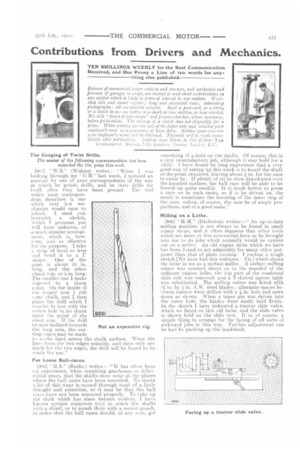Contributions from Drivers and Mechanics.
Page 19

If you've noticed an error in this article please click here to report it so we can fix it.
TEN SHILLINGS WEEKLY for the Best Communication Received, and One Penny a Line of ten words for any thing else published.
Drivers of commercial-motor vehic'es and tra:tors, and mechanics and foremen of garages or strops, are invited to send short contributions on any subject which is likely to prove of interest to our readers. Work. shop tips and smart repairs ; long and successful runs ; interesting photographs : all are Sliiiable subjects. Send a pact-card, or a letter, OY a sketch to us-no matter how short, OY how written, or how worded. We will " knock it into shape" and pre,barc sketches, where necessary, before publication. The absence of a sketch does not disqualify for a prise. When use one side of the paper 01-11V and mention your employer's now as a guarantee of bona fides. Neither your own nor your employer's no mum will be disclosed. Payment will be made immediately after puldication. Address your letters to The Editor, 'Ina CommEricrAt A1.01012. 7-15. lioseberv Avenue, Lon.hm. E.C.
The Gauging of Twist Drills.
The senaer of the following communication has been awarded the 10s. prize this week.
[90 " S." (Widnes) writes : —" When I was looking through my O.M.' last week, I noticed an account by one of your correspondents of the way in which he grinds drills, and he tests drills for truth after they have, been ground. The tool
which your correspondent describes is one which very few mechanics would care to afford. I send you herewith a sketch, which I presume you will have redrawn, of J1 much simpler arrangement, which is, however, just as effective for the purpose. I take a strip of steel or iron 4incl bend it to a 1.7 shape. One of the arms is about 18 in. long, and the other .about in. or 4 in. long. The smaller one I make tapered to a sharp point. On the inside of the longer arm I rub _,.oine chalk, and I then place the drill which I require to test with the centre hole in its shank upon ihe point of the short arm. If the drill be now inclined towards the long arm, the cutting edges may be made to seribe lines across the chalk surface. When the lines from the two edges coincide, and show only one mark for the two edges, the drill will be found to be ready for use."
Not an expensive rig.
For Loose Ball-races.
[905] "H.S." (Bucks.) writes It has often been
ray experience, when repairing gearboxes or differential gears, that the shafts show wear at the places -where the ball races have been mounted. No doubt. a lot of this wear is caused through want of a. little thought and attention, or it may be that the ball races have not been mounted properly. To take up the slack which has since become evident, I have known certain repairers (sic) to notch the shafts -with a chisel, or to punch them with a centre punch, in order that the ball races should, at any rate, get
something of a hold on the shafts. Of course, this is a very unsatisfactory job, although it may hold for a :vhile. I have found by long experience that a very good way of taking up this slack is to knurl the shaft at the point required, leaving about in. for the race to enter by. If plenty of oil be then distributed over the knurled surface, the ball race will be able to be forced On quite readily. It is much better to press a race on in such cases, as if it be driven on, the i result s sometimes the bursting of the inner ring of the race, unless, of course, the race be of ample proportions, and of a good make."
Milling on a Lathe.
[906] " H.M." (Darlaston) writes An up-to-date milling machine is not always to be found in small repair shops, and it often happens that other tools which are more or less convenient have to be brought into use to do jobs which normally would be carried out on a miller. An old engine lathe which we have has been found to act admirably for many other purposes than that. of plain turning. I enclose a rough sketch [We have had this redrawn.-En.) which shows the lathe in use as a surface miller. A surface milling cutter was screwed direct on to the mandril of the ordinary engine lathe, the top part of the combined slide rest was removed, and a T-slotted square table was substituted. The milling cutter was fitted with in. by I in. A.W. steel blades ; alternate spaces between cutters were drilled with a in. hole and sawn down as shown. When a taper pin was driven into the outer hole, the blades were easily held firmly. In the sketch I have indicated a tractor slide valve, which we faced on this old lathe, and the slide valve is shown held on the slide rest. It is, of course, a simple thing to arrange for the facing of all sorts of awkward jobs in this way. Further adjustment can be had by packing up the headstock.




















